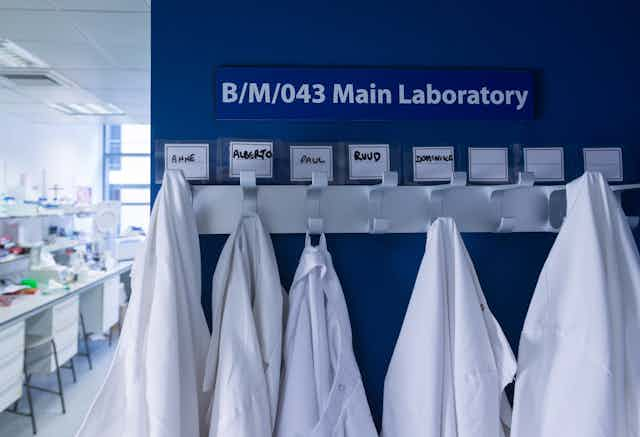Scientists are facing stiff headwinds from the rapid spread of COVID-19.
The coronavirus has been declared a pandemic by the World Health Organization and a national emergency in the U.S. While the impact of the pandemic on scientific research pales compared to its effect on human health and lives lost, it’s still affecting the vitality of an essential component of the modern world.
Universities around the country are the engines of research in the United States. They perform nearly half of the basic research and nearly one fifth of the applied research, totaling US$67 billion in 2018. Already, many universities have canceled classes or moved them online, and many have made contingency plans for complete closure. Exceptions will only be made for essential functions.
Which raises the question: Is scientific research essential? It’s not as essential as maintaining core health and human services, but as an expert in physics and astronomy, I’d argue that it’s more essential than sporting events or rock concerts, as much as I enjoy both. One half of America’s economic growth can be attributed to scientific and technological innovation.

What’s not getting done
Just on my campus at the University of Arizona, which is typical of large American Research 1 universities, a list of actions that affect research includes: suspension of all meetings with more than four people, suspension of all nonessential travel and plans for the closure of almost all labs and research facilities.
This a huge hit on the professional development of young scientists. It means that in my department, we can’t have colloquia or seminars or journal clubs. We can’t bring prospective graduate students to visit. We can’t have face-to-face meetings of research groups or even thesis committees. We can’t advise our students one-on-one. All these are venues where young people learn their craft and prepare to become independent researchers.
In 250 research universities and thousands of labs across the country, it’s the same story. At Boston University, biomedical engineer Catherine Klapperich reported to STAT that she’s canceling lab meetings, and that she can’t run experiments overnight, in case one day she isn’t allowed back in the building. Harvard biology professor Richard Lee told STAT he will ensure the mice in his lab are cared for, but he won’t be able to do experiments and his students may not be able to finish their thesis research. Harvard labs are all closed for two months, but at other universities it’s an open-ended closure, which is very disruptive to planning and executing research projects.
A glimpse of what lies ahead come from Italy, which is under lockdown. According to Science magazine, University of Pavia biologist Federico Forneris has mostly shut down his lab and may shift his research to computational biology, which can be done remotely. Geneticist Alberto Bardelli at the University of Turin, told Science that for him it’s a similar story. And in a bitter irony, he’s been stalled in his efforts to develop a diagnostic test for the coronavirus.
Holden Thorp, editor-in-chief of the premier journal Science, sums it up succinctly: “We’re going to lose a lot of science.”
Gatherings aren’t happening
Another dramatic effect of the pandemic is the mass cancellation of conferences.
Organizers pulled the plug on Experimental Biology, due to host 12,000 people in San Diego.
The American Physical Society was expecting 11,000 people in Denver, but canceled with one day’s notice, leaving many who had already arrived high and dry. Over 65 technology conferences have been canceled, postponed, or will go virtual. The National Institutes of Health hosts or sponsors hundreds of meetings per year; they’ve suspended all live events until the end of April.
Virtual meetings were on the rise even before COVID-19 hit. Going online helps scientists reduce their carbon footprint, so why not embrace this trend?
Because young scientists use meetings to hunt for jobs and get their work known. Young scientists have fresh ideas, and they’re ambitious and highly productive. If they suffer, the entire enterprise suffers.
Louise Prockter, co-chair of a recently canceled meeting on planetary science, told Scientific American, “They don’t have that opportunity to show off their science and network.” Karen Daniels, a physicist hit by the cancellation of the large Denver meeting, echoed this to the magazine saying, “You also go there to sit in the hallways and talk about what you just heard and your new ideas and what’s working and what’s not working.”
On paper, in any competitive field, everyone looks good. The way a young scientist shines is by giving a compelling talk, by fielding tough questions from their peers and by holding their own in a one-on-one with a senior scientist. Research supports the idea that in-person interactions are valuable.
Meetings matter. Without science’s social dimension, something valuable is lost.
Lessons to take forward
Is there a silver lining to this bleak picture? Yes. The imperative to share health data on COVID-19 will add to the pressure on academic journals to provide free access to research results. The for-profit publishing sector is already feeling heat, and the push for open access may become irresistible. Shared data is the fuel for scientific progress because small research groups can turn into large worldwide teams solving challenging problems.
Federal agencies such as the National Science Foundation have announced new funding opportunities, not just for medical research, but also for enhancing the cyber infrastructure to deal with health crises. New investments will focus on early warning, risk mitigation and resilience in dealing with pandemics like this one. Because the only certainty is that there will be another one.
[Deep knowledge, daily. Sign up for The Conversation’s newsletter.]

